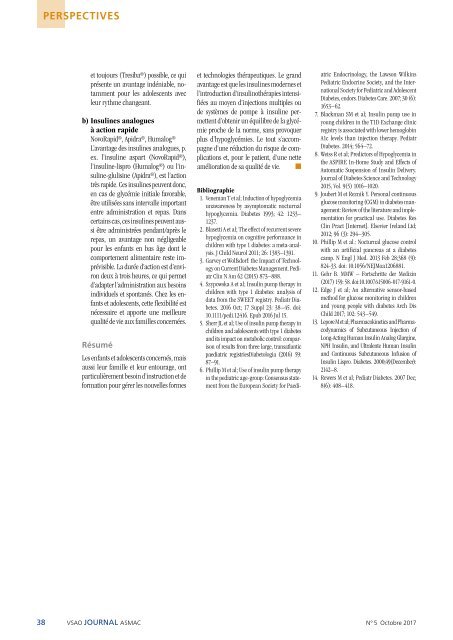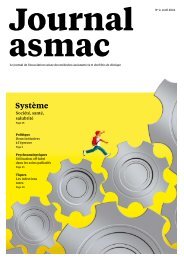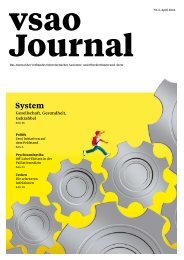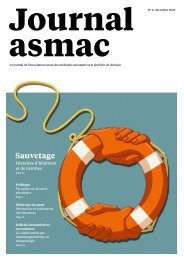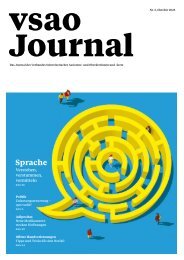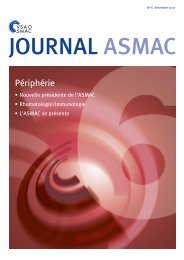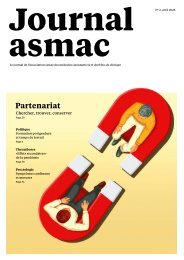JOURNAL ASMAC - No 5 - octobre 2017
Propreté - Diabète/Alimentation, Pilotage des admissions: prochaine étape
Propreté -
Diabète/Alimentation,
Pilotage des admissions: prochaine étape
Create successful ePaper yourself
Turn your PDF publications into a flip-book with our unique Google optimized e-Paper software.
PERSPECTIVES<br />
et toujours (Tresiba ® ) possible, ce qui<br />
présente un avantage indéniable, notamment<br />
pour les adolescents avec<br />
leur rythme changeant.<br />
b) Insulines analogues<br />
à action rapide<br />
<strong>No</strong>voRapid ® , Apidra ® , Humalog ®<br />
L’avantage des insulines analogues, p.<br />
ex. l’insuline aspart (<strong>No</strong>voRapid ® ),<br />
l’insuline-lispro (Humalog ® ) ou l’insuline-glulisine<br />
(Apidra ® ), est l’action<br />
très rapide. Ces insulines peuvent donc,<br />
en cas de glycémie initiale favorable,<br />
être utilisées sans intervalle important<br />
entre administration et repas. Dans<br />
certains cas, ces insulines peuvent aussi<br />
être administrées pendant/après le<br />
repas, un avantage non négligeable<br />
pour les enfants en bas âge dont le<br />
comportement alimentaire reste imprévisible.<br />
La durée d’action est d’environ<br />
deux à trois heures, ce qui permet<br />
d’adapter l’administration aux besoins<br />
individuels et spontanés. Chez les enfants<br />
et adolescents, cette flexibilité est<br />
nécessaire et apporte une meilleure<br />
qualité de vie aux familles concernées.<br />
Résumé<br />
Les enfants et adolescents concernés, mais<br />
aussi leur famille et leur entourage, ont<br />
particulièrement besoin d’instruction et de<br />
formation pour gérer les nouvelles formes<br />
et technologies thérapeutiques. Le grand<br />
avantage est que les insulines modernes et<br />
l’introduction d’insulinothérapies intensifiées<br />
au moyen d’injections multiples ou<br />
de systèmes de pompe à insuline permettent<br />
d’obtenir un équilibre de la glycémie<br />
proche de la norme, sans provoquer<br />
plus d’hypoglycémies. Le tout s’accompagne<br />
d’une réduction du risque de complications<br />
et, pour le patient, d’une nette<br />
amélioration de sa qualité de vie. ■<br />
Bibliographie<br />
1. Veneman T et al; Induction of hypoglycemia<br />
unawareness by asymptomatic nocturnal<br />
hypoglycemia. Diabetes 1993; 42: 1233–<br />
1237.<br />
2. Blasetti A et al; The effect of recurrent severe<br />
hypoglycemia on cognitive performance in<br />
children with type 1 diabetes: a meta-analysis.<br />
J Child Neurol 2011; 26: 1383–1391.<br />
3. Garvey et Wolfsdorf: the Impact of Technology<br />
on Current Diabetes Management. Pediatr<br />
Clin N Am 62 (2015) 873–888.<br />
4. Szypowska A et al; Insulin pump therapy in<br />
children with type 1 diabetes: analysis of<br />
data from the SWEET registry. Pediatr Diabetes.<br />
2016 Oct; 17 Suppl 23: 38–45. doi:<br />
10.1111/pedi.12416. Epub 2016 Jul 15.<br />
5. Sherr JL et al; Use of insulin pump therapy in<br />
children and adolescents with type 1 diabetes<br />
and its impact on metabolic control: comparison<br />
of results from three large, transatlantic<br />
paediatric registriesDiabetologia (2016) 59:<br />
87–91.<br />
6. Phillip M et al; Use of insulin pump therapy<br />
in the pediatric age-group: Consensus statement<br />
from the European Society for Paediatric<br />
Endocrinology, the Lawson Wilkins<br />
Pediatric Endocrine Society, and the International<br />
Society for Pediatric and Adolescent<br />
Diabetes, endors. Diabetes Care. 2007; 30 (6):<br />
1653–62.<br />
7. Blackman SM et al; Insulin pump use in<br />
young children in the T1D Exchange clinic<br />
registry is associated with lower hemoglobin<br />
A1c levels than injection therapy. Pediatr<br />
Diabetes. 2014; 564–72.<br />
8. Weiss R et al; Predictors of Hypoglycemia in<br />
the ASPIRE In-Home Study and Effects of<br />
Automatic Suspension of Insulin Delivery.<br />
Journal of Diabetes Science and Technology<br />
2015, Vol. 9(5) 1016–1020.<br />
9. Joubert M et Reznik Y. Personal continuous<br />
glucose monitoring (CGM) in diabetes management:<br />
Review of the literature and implementation<br />
for practical use. Diabetes Res<br />
Clin Pract [Internet]. Elsevier Ireland Ltd;<br />
2012; 96 (3): 294–305.<br />
10. Phillip M et al.: <strong>No</strong>cturnal glucose control<br />
with an artificial pancreas at a diabetes<br />
camp. N Engl J Med. 2013 Feb 28;368 (9):<br />
824-33. doi: 10.1056/NEJMoa1206881.<br />
11. Gehr B. MMW – Fortschritte der Medizin<br />
(<strong>2017</strong>) 159: 58. doi:10.1007/s15006-017-9161-0.<br />
12. Edge J et al; An alternative sensor-based<br />
method for glucose monitoring in children<br />
and young people with diabetes Arch Dis<br />
Child <strong>2017</strong>; 102: 543–549.<br />
13. Lepore M et al; Pharmacokinetics and Pharmacodynamics<br />
of Subcutaneous Injection of<br />
Long-Acting Human Insulin Analog Glargine,<br />
NPH Insulin, and Ultralente Human Insulin<br />
and Continuous Subcutaneous Infusion of<br />
Insulin Lispro. Diabetes. 2000;49(December):<br />
2142–8.<br />
14. Rewers M et al; Pediatr Diabetes. 2007 Dec;<br />
8(6): 408–418.<br />
38 VSAO <strong>JOURNAL</strong> <strong>ASMAC</strong> N° 5 Octobre <strong>2017</strong>


